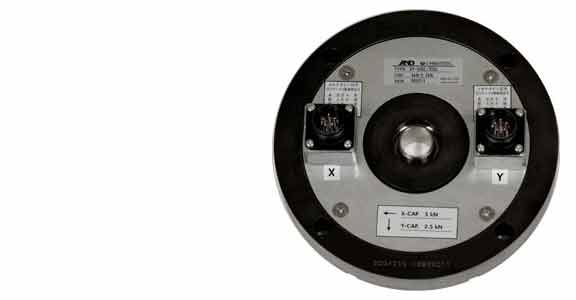News Flash
X-Y Load Cells and Tire Testers
Improving car fuel consumption to reduce greenhouse gas (CO2) emissions as an environmental measure continues to be a global theme in recent years. Japan has established a labeling system as a guideline to promote the widespread use of low fuel consumption tires and has been gradually introducing it since January 2010. This labeling system establishes grades for rolling resistance coefficient (5 grades) and wet grip performance (4 grades) and requires catalogs and websites to display grades for each tire.
The introduction of this system has focused attention on tire uniformity machines. A tire uniformity machine is an inspection unit that tire manufacturers use in their final inspections and finishing processes. Since tires are made by layering materials such as rubber, synthetic fibers, and steel cords, there is a lack of uniformity in dimension, weight, and hardness. This lack of uniformity creates uneven reactive force from the road in response to tire rotation. The unevenness of the reactive force of tires is known as tire uniformity.
A tire uniformity machine has a tire rotation axis that is attached to the tire to be measured, and a drum that has a rotation axis that is parallel to the tire rotation axis.
In a tire uniformity test, the drum contacts the tire and acts as the road surface. The reactive force the drum receives from the tire is measured while a constant distance is maintained between the both axes and rotation occurs at a constant speed.
If the tire rotation speed prescribed by JIS D 4233 is converted to vehicle wheel driving speed, it is a low speed of approximately 8 km/h. Since this speed cannot be used to accurately estimate tire uniformity that occurs during actual driving, high speed uniformity machines have been manufactured in recent years that can measure up to a maximum of 200 km/h.
The sensor used in these tire uniformity machines is an X-Y load cell.
The X-Y load cell has elastic portions in two directions at 90 degrees to each other and these elastic portions are equipped with strain gages. Both the X and Y directions are embedded into the bridge independently. When force is applied to the axis inserted into the center opening of the main unit, the strain and force of the elastic portions are converted to electric signals for detection.
A&D applies its abundant experience and expertise to create high quality and long-lasting load cells that satisfy its customers.
Furthermore, as a measurement device manufacturer, A&D not only makes load cells, but also indicators. For example, a combination of an X-Y load cell and our latest indicator, the AD-4532B, can be supplied for tire uniformity machines.
X-Y Load Cell Features:
- Simultaneous measurement of the X and Y-axis with one unit
- Solid, durable construction
- Minimal reciprocal interference when the X and Y-axis are simultaneously loaded

Features of the AD-4532B :
- New tricolor (orange, green, and red LED display)
- Enhanced comparator functions
- Hold function
- Wide variety of data input/output